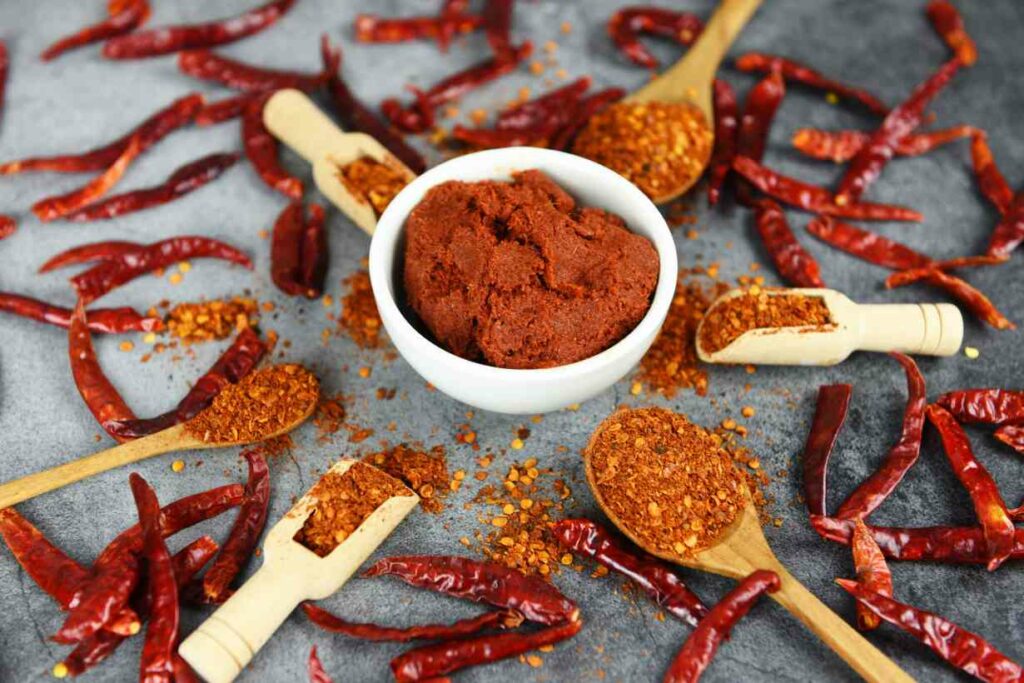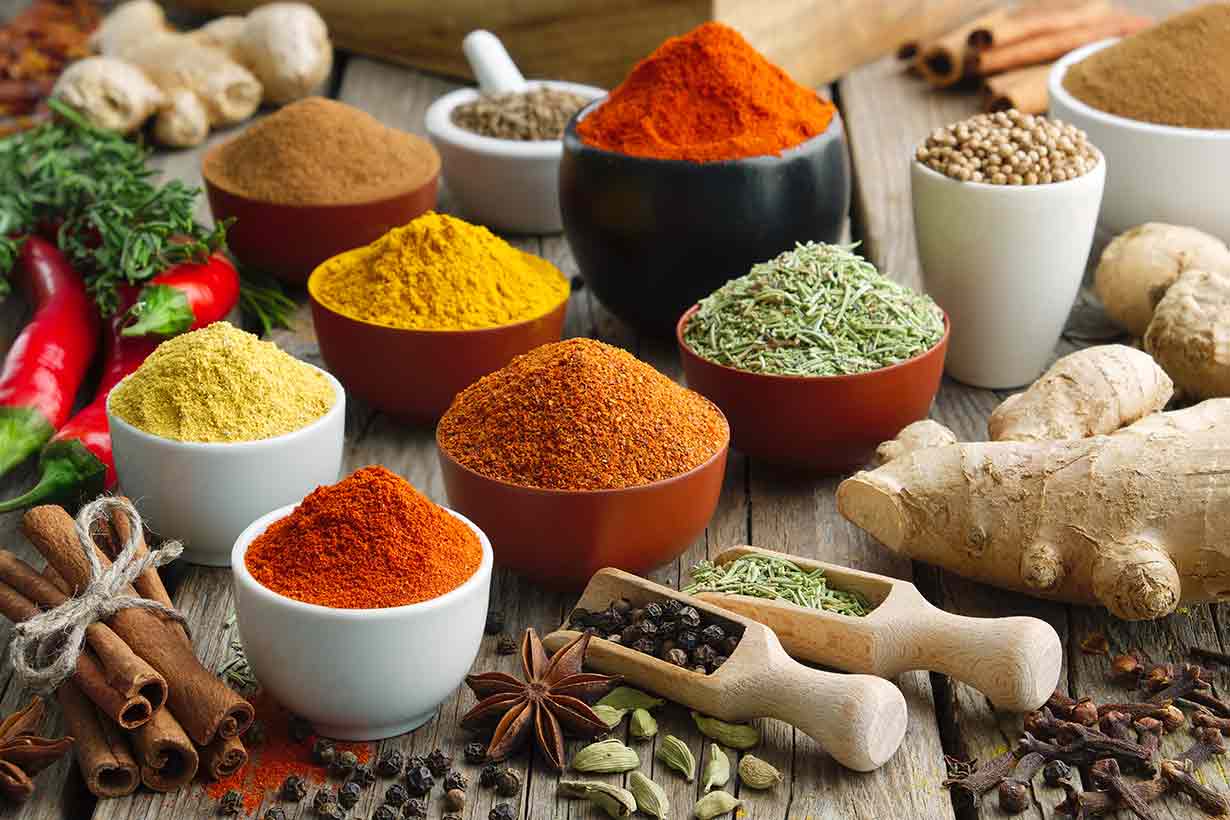Cayenne pepper is a popular spice that adds a lot of heat to food, but does it have any potential benefits?
This article examines the nutritional properties of cayenne pepper and its potential benefits and downsides.
Table of contents
What Is Cayenne Pepper?

The above image shows cayenne in two forms: dried peppers and dried pepper powder.
Cayenne pepper comes from two varieties of pepper known scientifically as Capsicum annum and Capsicum frutescens (1, 2).
As with most chili peppers in the Capsicum family, cayenne is used for flavoring and provides heat to various dishes.
Cayenne pepper is typically sold as a dried and powdered spice, allowing a simple way to “spice up” a dish. The spice is often used in curries, hot sauces, and marinades.
Although it isn’t in the hottest bracket of chili peppers, cayenne is still one of the most widely available medium-hot chili peppers.
The “heat” of cayenne pepper depends on how much capsaicin it contains. Capsaicin is a compound responsible for the heat and “burning” feeling chili peppers can provide (3).
The ‘Scoville scale,’ created in 1912, rates the heat level of peppers. Some peppers are incredibly mild with 0 Scoville heat units (such as bell peppers), whereas the hottest peppers have a rating of millions of Scoville heat units (4).
Cayenne pepper typically has a rating between 30,000 and 50,000 Scoville heat units, or approximately twelve times hotter than jalapeno (5).
What Does Cayenne Pepper Provide Nutritionally?
Firstly, cayenne pepper is nutrient-rich and contains many essential vitamins and minerals.
However, people use it in relatively small amounts, which limits the nutrient provision.
Nutrition Facts
The following tables show the full nutritional values of cayenne pepper powder per 5.3-gram tablespoon serving. The data source is the USDA’s FoodData Central database (6).
Daily values have been calculated using the USDA data and the FDA’s published daily values (7).
| Name | Amount | % Daily Value (DV) |
|---|---|---|
| Calories | 17 kcal | |
| Carbohydrates | 3.0 g | 1.1% DV |
| Fiber | 1.44 g | 5.1% DV |
| Sugars | 0.55 g | |
| Fat | 0.92 g | 1.2% DV |
| Saturated | 0.17 g | 0.9% DV |
| Monounsaturated | 0.15 g | |
| Polyunsaturated | 0.44 g | |
| Omega-3 | 0.03 g | |
| Omega-6 | 0.41 g | |
| Protein | 0.64 g | 1.3% DV |
| Cholesterol | 0 mg | 0% DV |
Vitamins
| Vitamin | Amount | % Daily Value |
|---|---|---|
| Choline | 2.73 mg | 0.5% DV |
| Folate | 5.62 mcg | 1.4% DV |
| Vitamin A | 110 mcg | 12.2% DV |
| Vitamin B1 (thiamin) | 0.017 mg | 1.3% DV |
| Vitamin B2 (riboflavin) | 0.049 mg | 3.8% DV |
| Vitamin B3 (niacin) | 0.461 mg | 2.9% DV |
| Vitamin B5 (pantothenic acid) | – | – |
| Vitamin B6 (pyridoxine) | 0.13 mg | 7.6% DV |
| Vitamin B12 (cobalamin) | 0 mcg | 0% DV |
| Vitamin C | 4.05 mg | 4.5% DV |
| Vitamin D | 0 mcg | 0% DV |
| Vitamin E | 1.58 mg | 10.5% DV |
| Vitamin K | 4.26 mcg | 3.6% DV |
Minerals
| Mineral | Amount | % Daily Value |
|---|---|---|
| Calcium | 7.84 mg | 0.6% DV |
| Copper | 0.02 mg | 2.2% DV |
| Iron | 0.413 mg | 2.3% DV |
| Magnesium | 8.06 mg | 1.9% DV |
| Manganese | 0.106 mg | 4.5% DV |
| Phosphorus | 15.5 mg | 1.24% DV |
| Potassium | 107 mg | 2.3% DV |
| Selenium | 0.466 mg | 0.8% DV |
| Sodium | 1.59 mg | 0.1% DV |
| Zinc | 0.131 mg | 1.2% DV |
Potential Health Benefits
Here are some potential health benefits of cayenne pepper based on nutritional data and scientific studies involving human participants.
Offers a Broad Range of Nutrients For Minimal Calories
The nutritional data tables show that a tablespoon serving of cayenne pepper contains only 17 calories (6).
However, despite the small serving size, a tablespoon supplies:
- More than 10% of the daily value for vitamins A and E
- A moderate amount of vitamin B6 (7.6% of the daily value)
- 5% of the daily value of fiber
- A broad range of vitamins and minerals in smaller amounts
Adding a bit of cayenne pepper to a dish is simple, and the spice is very low in calories.
Thus, it is an easy and effective way to increase the nutrient provision of a meal.
May Improve Muscular Endurance
Over the past decade, numerous published studies have looked into the effect of capsaicin on muscular and aerobic endurance. As previously mentioned, capsaicin is one of the main compounds found in cayenne pepper and is responsible for its heat sensation.
A systematic review and meta-analysis published in November 2022 investigated the effect of cayenne pepper on endurance performance (8).
This review examined fourteen published studies that provided a dose of capsaicin to participants before exercise:
- Seven studies evaluated the effect of capsaicin on muscular endurance
- Seven studies analyzed how capsaicin affected aerobic endurance
After analyzing the results data across all included studies, there was no significant difference between capsaicin and placebo for aerobic endurance.
However, there was a significant improvement in muscular endurance among participants taking a dose of capsaicin before exercise. This was primarily driven by decreased perceived exertion during exercise after taking a dose of capsaicin.
The most common capsaicin dose in the studies reviewed was 12 mg.
To put this dose into context, approximately 2.5 mg of capsaicin is in each gram of cayenne pepper powder (9, 10).
Thus, if consumed by one person, a 5.3-gram tablespoon serving would provide the 12 mg ‘common dose’ of capsaicin used in the studies.
May Lower LDL Cholesterol (LDL-C)
A systematic review and meta-analysis published in March 2022 examined the effect of capsaicin in patients with metabolic syndrome (11).
This review included nine randomized controlled trials (RCTs) that involved a total of 461 patients.
Notably, there was a significant decrease in LDL-C levels (sometimes referred to as “bad cholesterol”) in patients taking capsaicin compared to placebo.
Compared to the placebo group, patients supplementing capsaicin saw LDL-C levels lower by a mean of 0.23 mmol/L (8.89 mg/dL).
However, the researchers noted that the evidence is limited by the small number of patients involved in existing RCTs. Larger, high-quality RCTs are necessary to confirm capsaicin’s effect on LDL-C levels.
Potential Downsides
Alongside the potential benefits, research has highlighted some potential downsides to cayenne pepper intake.
Acid Reflux
Acid reflux is where stomach acid comes into the esophagus, and it can cause symptoms including heartburn and difficulty swallowing (12).
Reflux can be an occasional occurrence or a chronic condition known as gastroesophageal reflux disease (GERD) (13).
However, some foods are more associated with acid reflux than others, including cayenne pepper.
Firstly, large systematic reviews have demonstrated strong associations between spicy foods and acid reflux (14, 15).
Furthermore, several randomized controlled trials have shown that capsaicin intake can induce reflux in healthy adults and patients with GERD (16, 17, 18).
Anyone experiencing reflux symptoms from cayenne pepper (or any food) should discuss this with their medical team/doctor.
Allergies
Although rare, allergies to cayenne pepper have been reported in the scientific literature (19, 20).
According to the American Academy of Allergy, Asthma & Immunology, there have been several case reports of severe allergic reactions (anaphylaxis) to cayenne pepper (21).
How To Use Cayenne Pepper
Using cayenne pepper powder in cooking is quite simple, but paying attention to the dose is essential.
Since the spice is hot, starting with a smaller dose is better, and this can be increased if a spicier flavor is preferred.
Most recipes commonly call for around a teaspoon of cayenne, but this can be decreased or increased for a milder/spicier taste.
Adding cayenne pepper to the following foods and drinks can work well:
- Curries
- Dips
- Hot chocolate (just a tiny pinch)
- Marinades for fish, meat, or tofu
- Soups and stews
Where To Buy
Most medium-sized grocery stores will sell cayenne pepper.
The spice is available in many sizes, but buying a larger, bulk-sized pack can be more cost-effective.
There is also a wide range of cayenne pepper products available on Amazon (disclosure: affiliate link).
Final Thoughts
Cayenne pepper is a popular spice that can enhance the flavor of food.
Scientific research has highlighted some further possible benefits, such as its potential ability to improve muscular endurance and lower LDL-C levels.
That said, more research is necessary to confirm these potential benefits.
Overall, cayenne pepper has a good nutritional profile and provides a moderate amount of vitamins and minerals, even in small doses.


Useful information is always helpful. What additional benefits are there for Diabetics?
Besides animal studies and a couple of smaller studies with mixed results, there appears to be a lack of evidence for cayenne (or capsaicin) in this area.